This is named after Sir Henry Segrave who, in 1926, raised the land-speed record to 152mph in his 350hp 4.5-litre Sunbeam Ladybird, on Southport’s Birkdale Sands. At the turn of the 20th century, Southport was a leading venue for motor-racing. Henry Segrave was eventually knighted, dying in June 1930, having just set a new world record on Lake Windermere.
Text about The Sir Henry Segrave.

The text reads: The building that you are now in was built in c1880, and within a few years was wholly occupied by CF Chinnery’s furnishing emporium. Chinnery remained here until the 1930s. The ground floor is now occupied by The Sir Henry Segrave freehouse. In 1926 Segrave achieved a new land speed record of 152mph on Birkdale Sands.
An illustration and text about The ‘Never-Never’ Railway.
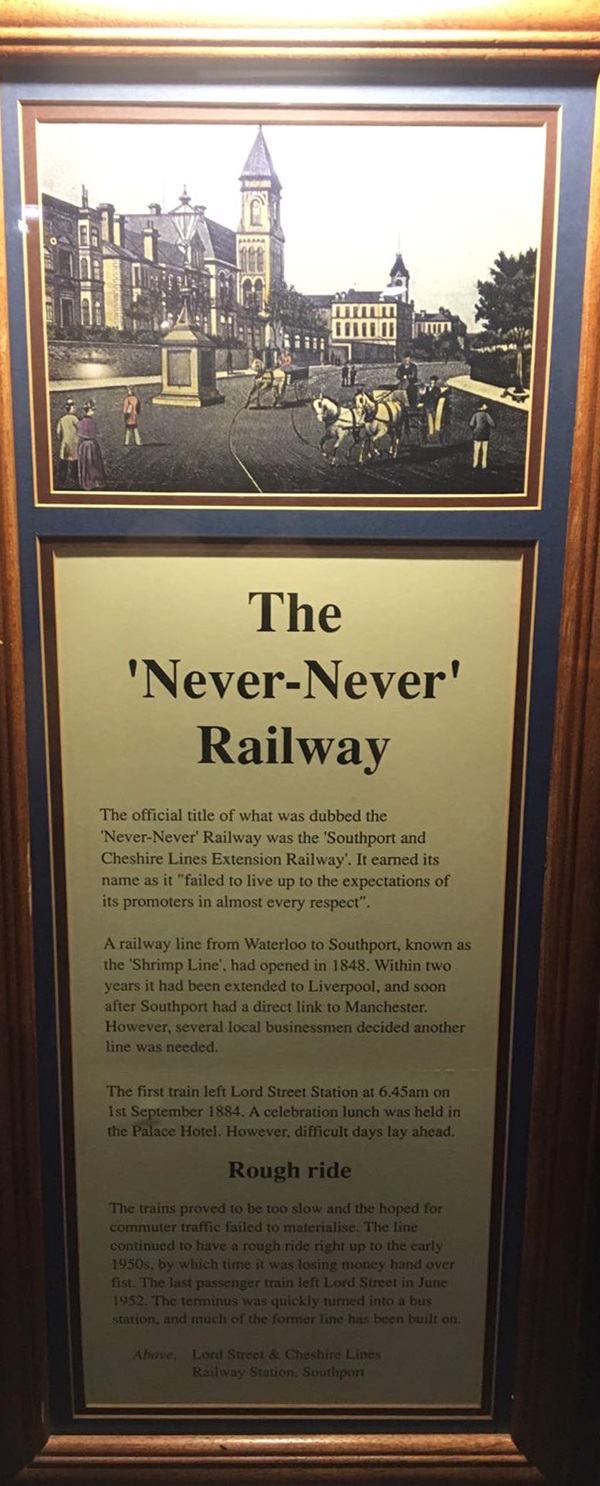
The text reads: The official title of what was dubbed the ‘Never-Never’ Railway was the Southport and Cheshire Lines Extension Railway. It earned its name as it “failed to live up to the expectations of its promoters in almost every respect”.
A railway line from Waterloo to Southport, known as the ‘Shrimp Line’, had opened in 1848. Within two years it had been extended to Liverpool, and soon after Southport had a direct link to Manchester. However, several local businessmen decided another line was needed.
The first train left Lord Street Station at 6:45am on 1 September 1884. A celebration lunch was held in the Palace Hotel. However, difficult days lay ahead.
The trains proved to be too slow and the hoped for commuter traffic failed to materialise. The line continued to have a rough ride right up to the early 1950s, by which time it was losing money hand over fist. The last passenger train left Lord Street in June 1952. The terminus was quickly turned into a bus station, and much of the former line has been built on.
Above: Lord Street and Cheshire Lines Railway Station, Southport.
Illustrations and text about the Victoria Baths.

The text reads:
Built at a cost of £6,000, the original Victoria Baths opened in 1838 with much ceremony. Situated on the Promenade, it provided an all-year round alternative to sea-bathing.
A new improved baths opened in 1871 at a cost in excess of £40,000. The facilities included 69 private fresh water baths (first, second and third class) and a wide variety of “special provisions for the elderly and delicate persons”.
In addition to several large plunge baths filled with filtered sea-water, there were swimming lessons and aquatic displays. There was also a first class restaurant, a coffee bar, as well as billiard rooms and accommodation for 120 visitors.
The baths were purchased by the Corporation in 1919.
Illustrations and text about the Winter Gardens.
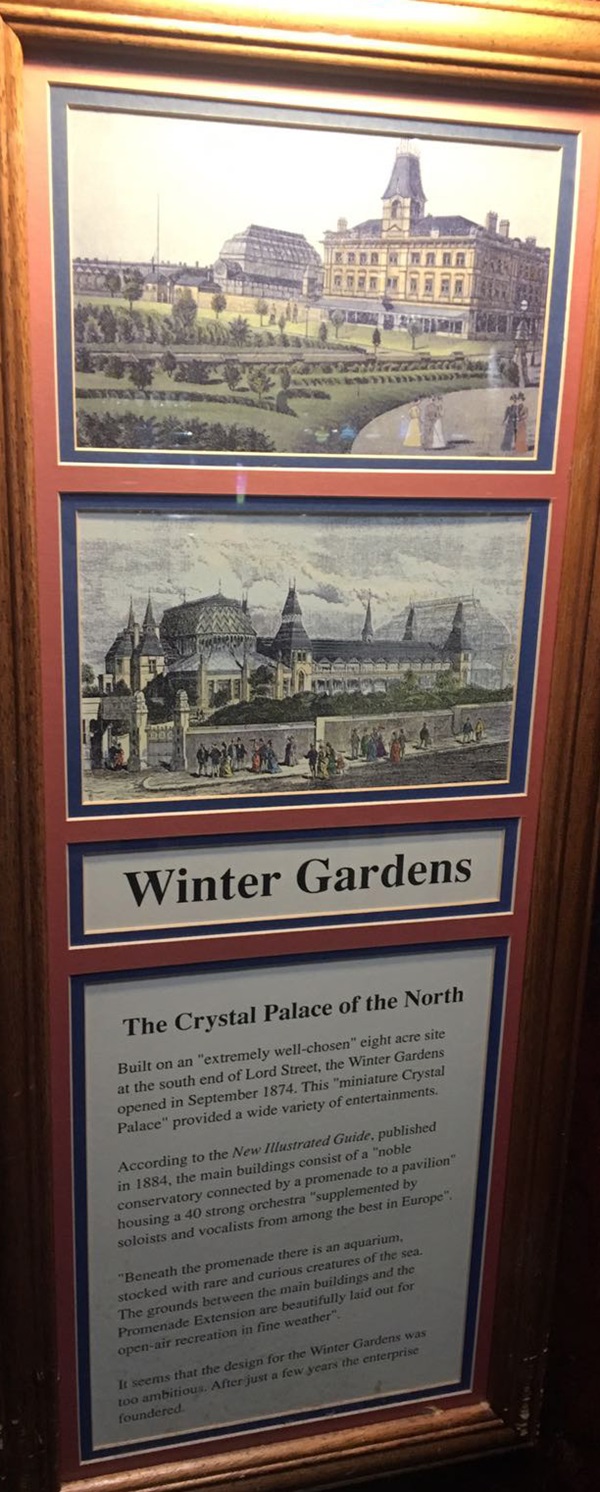
The text reads: Built on an “extremely well-chosen” eight acre site at the south end of Lord Street, the Winter Gardens opened in September 1874. This “miniature Crystal Palace” provided a wide variety of entertainments.
According to the New Illustrated Guide, published in 1884, the main buildings consist of a “noble conservatory connected by a promenade to a pavilion” housing a 40 strong orchestra “supplemented by soloists and vocalists from among the best in Europe”.
“Beneath the promenade there is an aquarium, stocked with rare and curious creatures of the sea. The grounds between the main buildings and the Promenade Extension are beautifully laid out for open-air recreation in fine weather”.
It seems that the design for the Winter Gardens was too ambitious. After just a few years the enterprise foundered.
Prints and text about William Ewart Gladstone.
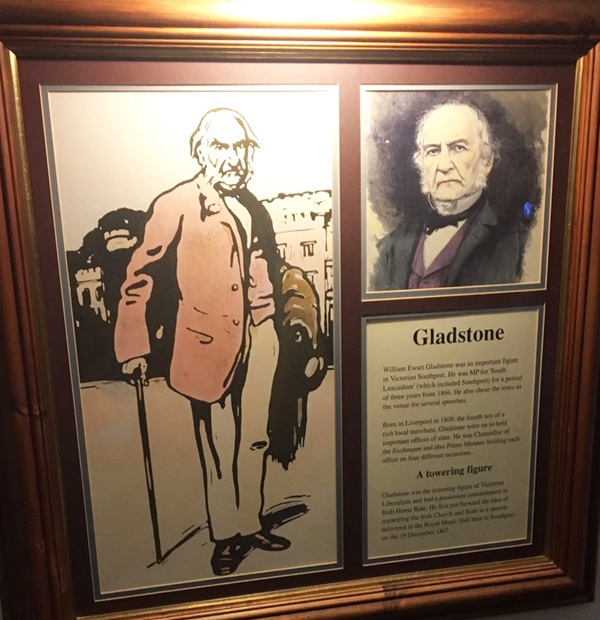
The text reads: William Ewart Gladstone was an important figure in Victorian Southport. He was MP for South Lancashire (which included Southport) for a period of three years from 1866. He also chose the town as the venue for several speeches.
Born in Liverpool in 1809, the fourth son of a rich local merchant, Gladstone went on to hold important offices of state. He was chancellor of the exchequer and also prime minister, holding each office on four different occasions.
Gladstone was the towering figure of Victorian Liberalism and had a passionate commitment to Irish Home Rule. He first put forward the idea of separating the Irish Church and State in a speech delivered in the Royal Music Hall here in Southport in the 19 December 1867.
An illustration and text about George Nathaniel Curzon.

The text reads: One of the outstanding public figures of his age, George Nathaniel Curzon was MP for Southport for 12 years from 1886. In many ways he was the very symbol of Victorian society.
Curzon never doubted that women and “lesser breeds” were unfit for any sort of political role. Nor did he question that the British Empire existed for the benefit of all mankind.
Above all he was guided by an undying faith in his own ability as well as his right and duty to govern. When Curzon was at Oxford University a friend penned a most appropriate rhyme:
My name is George Nathaniel Curzon,
I am a most superior person,
My cheek is pink, my hair is sleek,
I dine at Blenheim once a week.
Curzon was elected MP for Southport at the age of 27. However, his sights were not set on a conventional political career. He was a poor attender at Westminster and a darling of high society. At one time, according to a biography, he had 12 mistresses.
However, his career progressed and in 1898 Curzon was appointed viceroy of India; the ruler of 300 million people. He was without doubt “one of the principal architects of modern India”.
When he eventually returned to England Curzon’s political career included the post of foreign secretary. He was destined to become leader of the Tory Party, but during the 1920s he seemed to belong to a dying breed. After all he was the last would-be prime minister not to have a telephone in his own home.
An illustration and text about royal visitors to the area.

The text reads: Just a few years after William ‘Duke’ Sutton established his hotel, he received a royal visit from Prince William of Gloucester, nephew of George III.
The Prince (who was commander of the North West District) had come to inspect the coastal defenses, at a time when there was feverish speculation about a French invasion.
Having arrived in Liverpool, where he was received with much pomp and circumstance, the Duke of Gloucester made a tour of inspection of the region. Following the royal visit, Sutton’s ‘Original Hotel’ became known as the ‘Royal Hotel’.
A second royal visit took place a few years later in 1815. It seems to have been rather unintended. An account written much later, tell how Prince Louis Philipe (later King of France from 1830 to 1848) came to Southport.
The Prince was in the area as a guest of Charles Robert Blundell of Ince Hall. During a shooting party he found himself too far from his host’s house to return that night, and took refuge at the Union Hotel.
Above: Louis Philipe.
Prints and text about motor-racing in Southport.
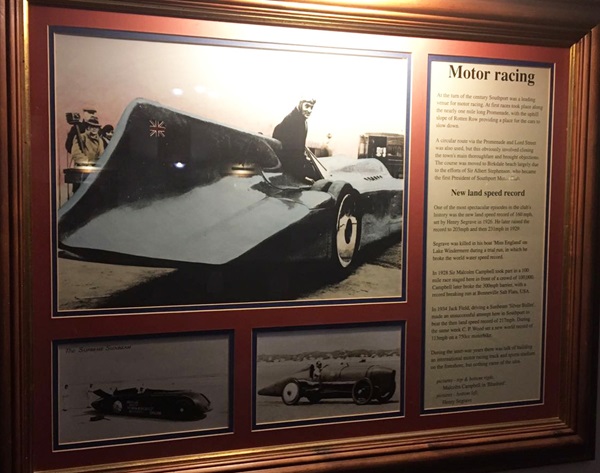
The text reads: At the turn of the century Southport was a leading venue for motor racing. At first races took place along the nearly one mile long Promenade, with the uphill slope of Rotten Row providing a place for the cars to slow down.
A circular route via the Promenade and Lord Street was also used, but this obviously involved closing the town’s main thoroughfare and brought objections. The course was moved to Birkdale Beach largely due to the efforts of Sir Albert Stephenson, who became the first president of Southport Motor Club.
One of the most spectacular episodes in the club’s history was the new land speed record of 160mph, set by Henry Segrave in 1926. He later raised the record to 203mph and then 231mph in 1929.
Segrave was killed in his boat Miss England on Lake Windermere during a trial run, in which he broke the world water speed record.
In 1928 Sir Malcom Campbell took part in a 100 mile race staged here in front of a crowd of 100,000. Campbell later broke the 300mph barrier, with a record breaking run at Bonneville Salt Flats, USA.
In 1934 Jack Field, driving a Sunbeam Silver Bullet, made an unsuccessful attempt here in Southport to beat the then land speed record of 217mph. During the same week CP Wood set a new world record of 113mph on a 750cc motorbike.
During the inter-war years there was talk of building an international motor racing track and sports stadium on the foreshore, but nothing came of the idea.
Top and bottom right: Malcom Campbell in Bluebird
Bottom left: Henry Segrave.
An illustration and text about the ‘founder’ of Southport.

The text reads: Until the late 18th century Southport – then known as South Hawes – was a quite bathing place. As the sea-bathing craze gathered momentum, more and more visitors were attracted to the area.
Accommodation at this time was restricted to a few inns in Churchtown, from where visitors were taken to the beach in carts and wagons. In 1792 William Sutton, the proprietor of the Black Bull, decided to build a bathing hut in what is now Duke Street.
A number of other dwellings soon followed, including Belle Vue Cottage, built for Mrs Sarah Walmesley for the accommodation of paying guests.
According to tradition it was during the celebrations which accompanied the opening of Sutton’s new building, that a guest declared that the area should be known as South Port.
Sutton’s new venture, built in 1798 and standing in six acres, was known as South Port Hotel. It also had a number of other names, including Eagle and Child, Original Hotel, Royal Hotel and Royal Original Hotel.
Although “some of the best families” visited his hotel, Sutton died in Churchtown aged 88 in much reduced circumstances. In 1860 a monument was erected to William Sutton ‘The Founder of Southport’.
Above: The Original Hotel, 1845.
Prints and text about motor-racing in Southport.
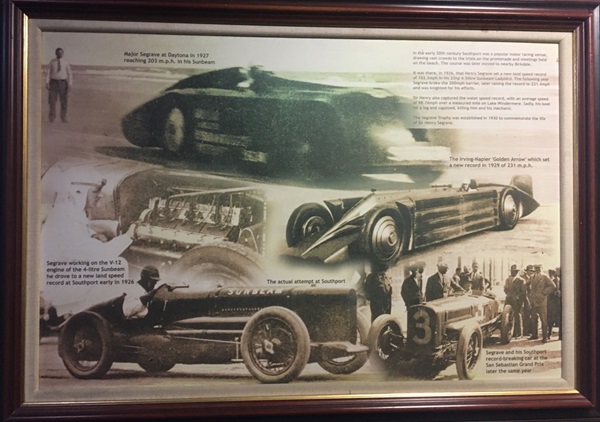
The text reads: In the early 20th century Southport was a popular motor racing venue, drawing vast crowds to the trials on the promenade and meetings held on the beach. The course was later moved to nearby Birkdale.
It was there, in 1926, that Henry Segrave set a new land speed record of 152.3mph in his 33hp 4.5 litre Sunbeam Ladybird. The following year Segrave broke the 200mph barrier, later raising the record to 231.4mph and was knighted for his efforts.
Sir Henry also captured the water speed record, with an average speed of 98.76mph over a measured mile on Lake Windermere. Sadly, his boat hit a log and capsized, killing him and his mechanic.
The Segrave Trophy was established in 1930 to commemorate the life of Sir Henry Segrave.
A print of Southport Promenade, c1909.
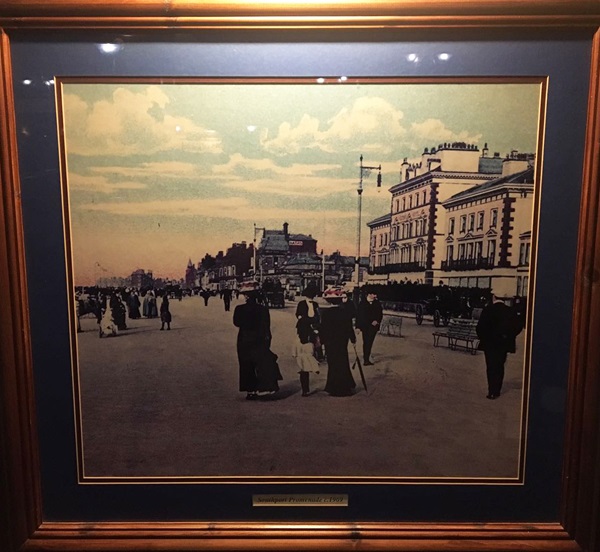
External photograph of the building – main entrance.
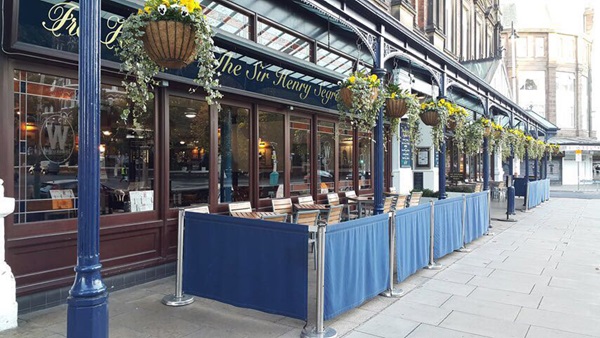
Extract from Wetherspoon News Summer 2019.
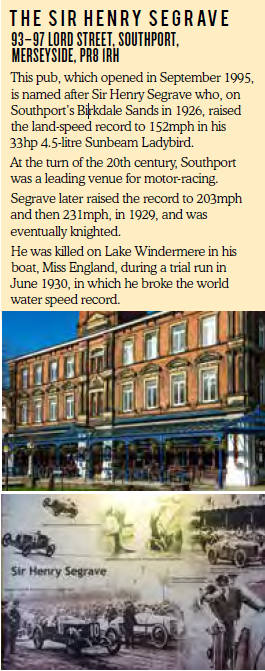
If you have information on the history of this pub, then we’d like you to share it with us. Please e-mail all information to: pubhistories@jdwetherspoon.co.uk